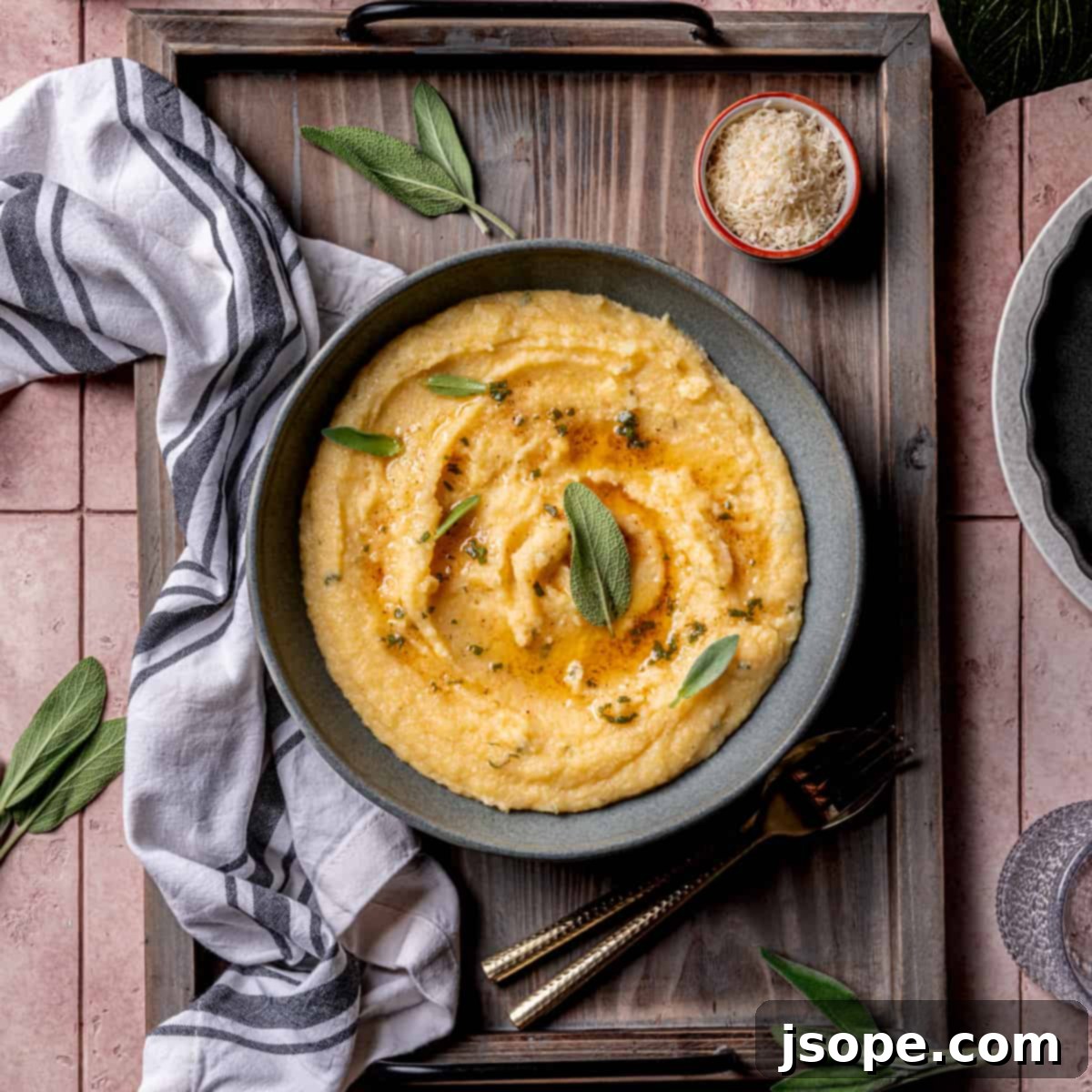Welcome to a culinary journey that promises to elevate your perception of comfort food. While potatoes, rice, and pasta often dominate the starch landscape in many American kitchens, a delightful alternative awaits: creamy Italian polenta. This versatile and incredibly satisfying dish, originating from Northern Italy, transforms humble ground corn into a luxurious canvas for rich flavors. Our Brown Butter and Sage Polenta recipe is not just a dish; it’s an experience, a symphony of savory notes that can stand proudly as a main course or perfectly complement a variety of other meals.
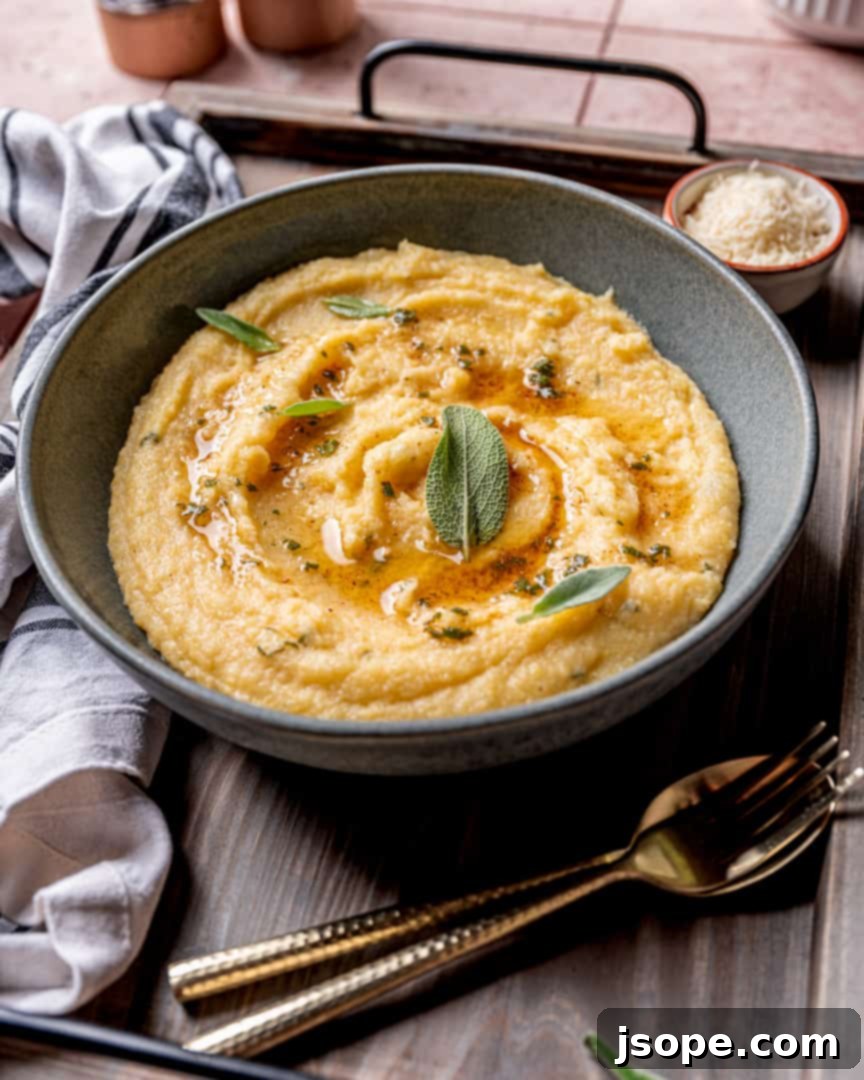
The magic truly happens when polenta meets brown butter and sage. Brown butter, with its distinct nutty aroma and deep, caramel-like notes, forms an unparalleled partnership with the warm, earthy essence of fresh sage. This classic Italian flavor combination imbues the smooth, golden polenta with an extraordinary depth, transforming it into a heavenly side dish or a surprisingly robust main course. Perfect for a cozy holiday feast or a simple weeknight dinner, this recipe is a testament to the power of simple, high-quality ingredients coming together in harmony. While it’s a staple for holiday roasts, its deliciousness transcends seasons, making it a beloved dish all year round.
If you’re eager to explore more polenta creations, don’t miss our other enticing recipes such as Parmesan Polenta, a delightful take on classic flavors, or the decadent Smoked Gouda and Porcini Mushroom Polenta, offering a more gourmet twist.
Understanding Polenta: A Northern Italian Staple
Often misunderstood as merely an ingredient, polenta is, in fact, the finished dish itself – a comforting porridge-like preparation made from ground cornmeal. Its roots trace back to Northern Italy, where it has been a culinary cornerstone for centuries, evolving from ancient grains to the specific type of cornmeal we recognize today. The primary ingredient in authentic polenta is coarse ground flint corn, traditionally cultivated in Italy. This particular corn varietal yields a distinct texture and mouthfeel when cooked, different from common cornmeal or American grits. While the vibrant yellow variety is most prevalent and offers a familiar “corn” flavor, a delicate white polenta is also available and can be used interchangeably, offering a slightly milder taste profile.
Instant vs. Traditional Polenta: A Matter of Time and Taste
When selecting polenta, you’ll typically encounter two main types: “instant” and “classic” (which we refer to as traditional or regular polenta). The key difference lies in their preparation. Instant polenta has undergone a pre-cooking and re-drying process, significantly reducing its cooking time at home. It can be ready in as little as 3 minutes, making it an incredibly convenient option for busy cooks. In contrast, traditional polenta requires a more leisurely approach, often needing 30 minutes or more of active cooking and frequent, vigorous stirring to achieve its characteristic creamy consistency. While traditional polenta generally offers a superior depth of flavor and texture in the final dish, its longer cooking time and sometimes limited availability in grocery stores often lead home cooks to opt for the instant variety. For this particular recipe, we’ve chosen instant polenta to ensure accessibility and a quicker preparation without compromising too much on taste or luxurious texture.
Polenta vs. Grits: Unpacking the Corn Connection
Both polenta and grits are beloved comfort foods derived from ground corn, yet they possess distinct characteristics stemming from the type of corn used and the milling process. Polenta is traditionally made from flint corn, known for its hard, starchy kernels, which result in a more uniform and somewhat flaky texture when ground. Grits, on the other hand, originate from dent corn, characterized by its softer, more starchy interior, leading to an irregular and typically coarser grind. Furthermore, dent corn tends to have a slightly higher starch content than flint corn. This means that if prepared identically, grits would likely yield a slightly creamier consistency. While similar in concept, these subtle differences in corn variety and grind contribute to the unique appeal of each dish, though grits can certainly be a viable substitute for polenta in many recipes, including this one, if needed.
The Flavors You’ll Adore: Why This Brown Butter and Sage Polenta Shines
This Brown Butter and Sage Polenta isn’t just a recipe; it’s a celebration of rich, comforting flavors and simple elegance. What makes it truly special is the exquisite combination of textures and aromas that awaken the palate. The luscious creaminess of perfectly cooked polenta provides a comforting base, while the nutty, toasted notes of brown butter add an incredible depth that’s both sophisticated and utterly satisfying. Fresh sage introduces an aromatic, slightly peppery warmth that beautifully cuts through the richness, creating a balanced and harmonious profile. Finished with savory Parmigiano Reggiano, this dish offers a delightful umami boost and an even silkier texture. It’s incredibly versatile, serving as an impressive side for special occasions or a hearty, standalone meal. The ease of preparation, especially with instant polenta, means you can achieve gourmet results with minimal fuss, making it a perfect addition to any home cook’s repertoire.
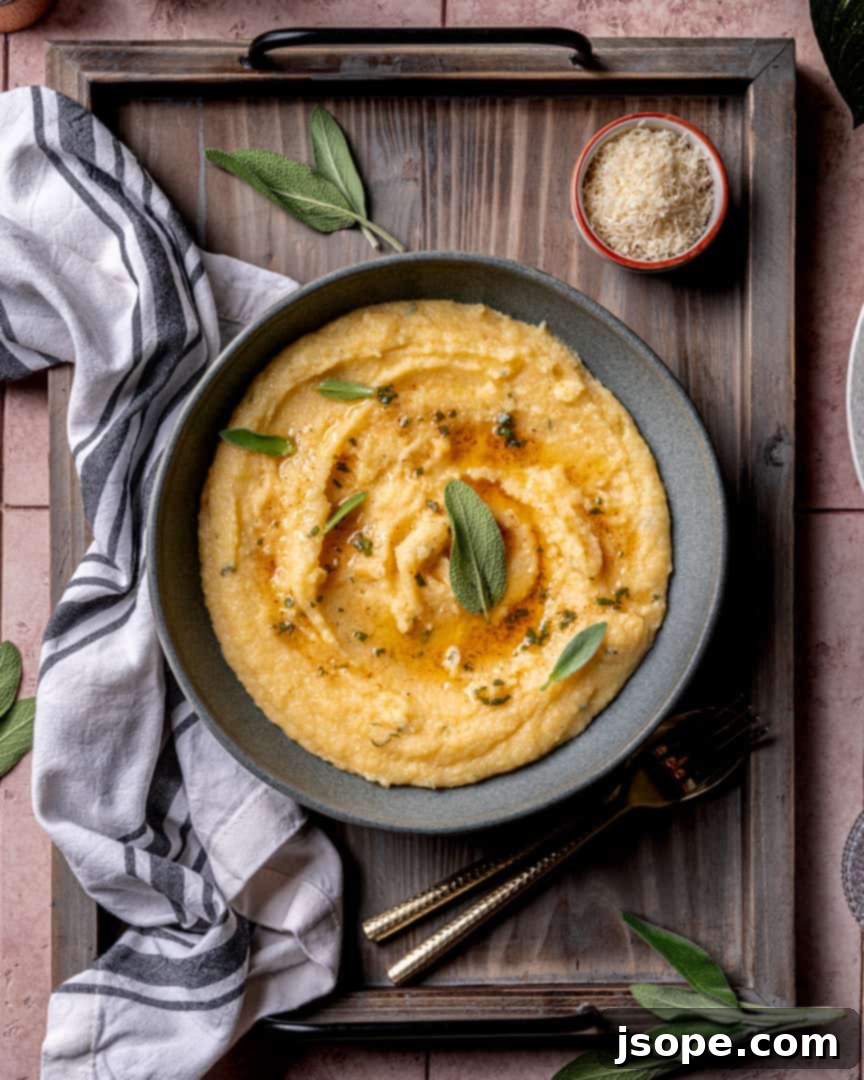
Essential Ingredients for Your Brown Butter and Sage Polenta
Crafting this delightful Brown Butter and Sage Polenta requires a thoughtful selection of ingredients, each playing a crucial role in achieving the dish’s signature flavor and luxurious texture:
- Instant Polenta: Our recipe leverages instant yellow polenta for its convenience and widespread availability. Its quick-cooking nature makes this dish achievable even on busy weeknights. If you opt for traditional classic polenta, be prepared for a longer cooking time and more extensive stirring, though the fundamental preparation steps remain largely similar.
- Vegetable Stock: To infuse our polenta with a deeper, more complex flavor profile, we highly recommend using a low or no-sodium vegetable stock instead of plain water. This addition enriches the dish, making it a more robust and satisfying experience. The lower sodium content allows you to control the seasoning precisely.
- Unsalted Butter: This is a star ingredient, divided for two distinct purposes. A significant portion is meticulously browned to create the wonderfully nutty, aromatic foundation of this dish. The remaining butter is incorporated at the very end to enhance the polenta’s creaminess and richness, ensuring a silky-smooth finish.
- Fresh Sage: The co-star of our recipe, fresh sage offers an unmistakable warm, earthy, and slightly peppery flavor that perfectly complements the nuttiness of brown butter. Its aromatic presence elevates the polenta from a simple cornmeal dish to a truly gourmet experience. Always opt for fresh sage leaves for the best flavor.
- Parmigiano Reggiano: Quality cheese is paramount for authentic Italian flavor. We specify a good quality, real Parmesan cheese, ideally Parmigiano Reggiano sourced from Italy. Its sharp, salty, and umami notes melt beautifully into the polenta, adding an essential layer of savory complexity.
- Kosher Salt: A fundamental seasoning that brings all the flavors into balance. Polenta, being somewhat bland on its own, benefits greatly from careful seasoning, so always taste and adjust.
- Fresh Ground Black Pepper: Adds a subtle warmth and a gentle aromatic kick, enhancing the overall flavor without overpowering the delicate nuances of brown butter and sage.
Clever Substitutions to Personalize Your Polenta
This recipe is wonderfully adaptable, allowing for several common substitutions to cater to dietary preferences or ingredient availability:
- For Vegetable Stock: While vegetable stock significantly boosts flavor, water can certainly be used in its place, though you might notice a slight reduction in the dish’s overall depth. For a different flavor profile, especially if serving with a specific protein, feel free to use other stocks such as chicken, beef, or even a delicate seafood or fish stock.
- For Polenta: If polenta isn’t readily available, coarse-ground grits make a perfectly acceptable substitute. While they are distinct products (as discussed previously), grits will yield a delicious and creamy dish with a similar comforting appeal.
- For Parmesan: A variety of other hard grating cheeses can beautifully complement this dish. Consider using Asiago for a sharper, nuttier flavor, or an aged Pecorino Romano for a tangier, more robust sheep’s milk cheese alternative.
- For Brown Butter: If the distinct flavor of brown butter isn’t to your liking, or if you’re short on time, you can use regular whole butter instead. While you’ll miss the unique nutty notes, the polenta will still be wonderfully creamy and flavorful.
- For Sage: Experiment with other fresh herbs like rosemary, thyme, or oregano for a different aromatic twist.
Crafting Your Brown Butter and Sage Polenta: A Step-by-Step Guide
This recipe is designed for ease and efficiency, making it incredibly quick to prepare on your stovetop, especially when using instant polenta. The process is straightforward: first, create your aromatic brown butter, then cook the polenta, and finally, bring all the delicious components together in one creamy, flavorful dish. Mastering brown butter takes only a few minutes, and instant polenta cooks remarkably fast, ensuring a gourmet meal can be on your table in no time.
Essential Equipment for Success
You won’t need any specialized kitchen gadgets for this recipe; just a few common and practical tools will suffice:
- A small, shallow sauté pan or skillet is ideal for browning the butter evenly, allowing you to observe its color change and prevent burning.
- A medium pot or saucepan will be your vessel for cooking the polenta, providing ample space for stirring and expansion.
- A sturdy wooden spoon is recommended for stirring the polenta, as it effectively scrapes the bottom of the pot, preventing sticking and ensuring a consistently smooth texture.
Detailed Step-by-Step Instructions for Brown Butter Sage Polenta
Step 1: Prepare the Fresh Sage
- Begin by finely chopping your fresh sage leaves. This is a crucial first step, as you’ll need the chopped sage ready to incorporate into the brown butter immediately after it’s prepared. The small pieces ensure an even distribution of flavor throughout the polenta.
Step 2: Master the Art of Brown Butter
- In your chosen shallow sauté pan or small skillet, melt 6 tablespoons of unsalted butter over medium heat. Continue cooking, gently swirling the pan occasionally, until the butter begins to foam, the milk solids separate and sink, and they transform into a beautiful golden-brown color. You’ll notice a distinctive nutty aroma, reminiscent of toasted hazelnuts. This process typically takes about 5 minutes. Once browned, immediately remove the pan from the heat to prevent burning. Carefully pour the brown butter, including all the delightful browned bits at the bottom, into a small heatproof bowl. Stir in the chopped fresh sage at this point, allowing its flavor to infuse into the warm brown butter. Set this aromatic mixture aside.
Step 3: Cook the Creamy Polenta
- In a medium to large saucepan, bring the vegetable stock to a rolling boil. Once boiling, remove the saucepan from the heat. This prevents the polenta from clumping upon contact with intensely boiling liquid. While constantly and vigorously stirring with your wooden spoon, slowly drizzle in the instant polenta. It is vital to add the polenta gradually and stir continuously to ensure a smooth, lump-free consistency. Continue stirring for 2-3 minutes as the polenta absorbs the liquid and thickens into a creamy consistency. If the polenta appears too thick at this stage, you can loosen it with a splash of additional warm vegetable stock or water.
Step 4: Finish and Serve Your Culinary Masterpiece
- Now, it’s time to bring all the flavors together. Gently add the brown butter and sage mixture to the cooked polenta. Stir thoroughly until the butter is completely incorporated and the sage is evenly distributed. This may take a minute or two, so be patient. Next, stir in the grated Parmigiano Reggiano cheese, kosher salt, and fresh ground black pepper until fully combined. Finally, add the remaining 2 tablespoons of whole unsalted butter and stir until it melts and contributes to the polenta’s luscious creaminess. Taste the polenta and adjust the seasoning as needed. Transfer the finished Brown Butter and Sage Polenta to a warm serving bowl and serve immediately, perhaps garnished with a few extra fresh sage leaves for an elegant touch.
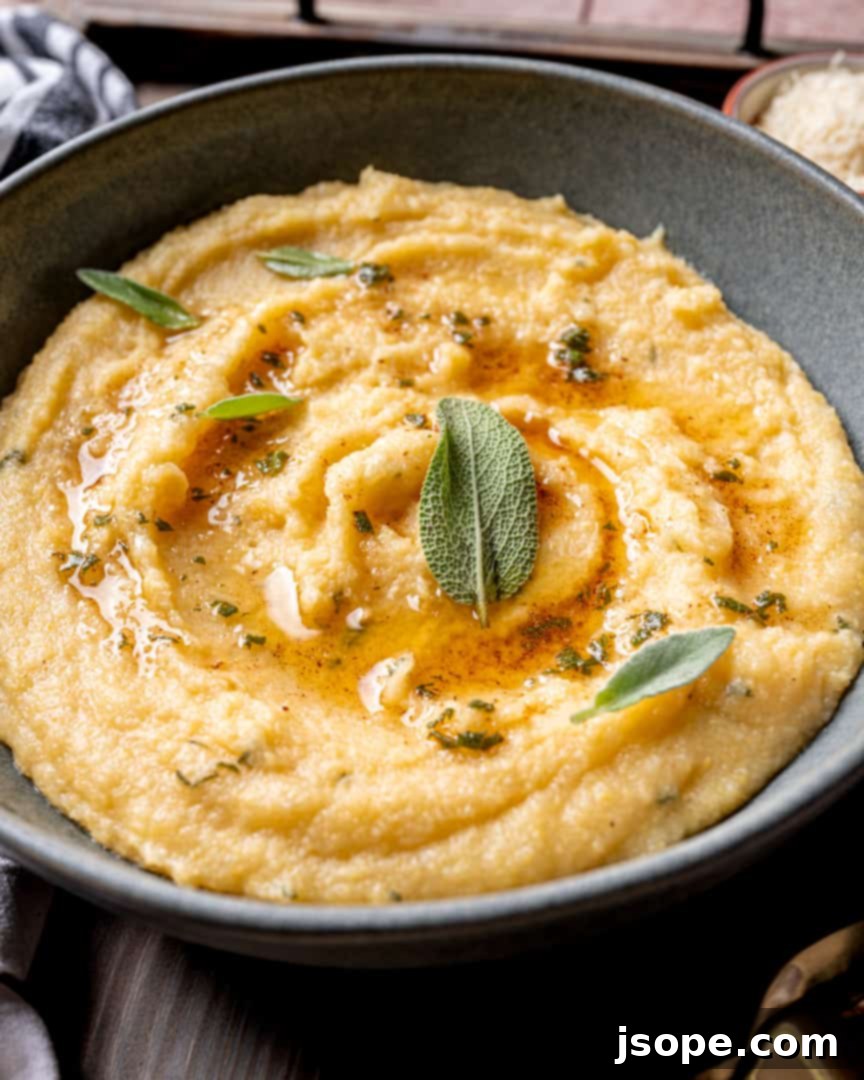
Exciting Variations to Elevate Your Polenta
This Brown Butter and Sage Polenta recipe is a fantastic starting point, but its versatility truly shines when you start exploring variations. Here are some delightful ways to customize your dish:
- Experiment with Different Herbs! While sage is a classic pairing, other fresh herbs can introduce wonderful new dimensions. Try incorporating finely chopped fresh rosemary for a more robust, piney aroma, thyme for a subtle earthy note, or even a mix of Italian parsley and chives for a brighter, fresher flavor. Fresh herbs are always preferred for their vibrant taste and aroma.
- Turn Up the Heat! If you enjoy a touch of spice, infuse a gentle warmth by adding a pinch or two of crushed red pepper flakes to the brown butter as it cooks, or stir them directly into the finished polenta for a more pronounced kick. A tiny dash of cayenne pepper could also do the trick.
- Indulge in Extra Creaminess. For an even richer and more decadent polenta, stir in a spoonful or two of heavy cream, mascarpone cheese, or even crème fraîche during the final steps of preparation. This adds a velvety texture and an extra layer of luxuriousness.
- Change the Cheese, Change the Flavor. The type of cheese you use can dramatically alter the final flavor profile. Beyond Parmigiano Reggiano, consider Pecorino Romano for a sharper, saltier kick, or Asiago for its nutty, slightly pungent notes. A smoked Gouda would offer a delightful smoky undertone, while a mild Fontina could provide a wonderfully melty, less assertive creaminess. Feel free to use any hard grating cheese you adore!
- Add Roasted Garlic or Sautéed Mushrooms. For an extra layer of umami and depth, roast a head of garlic, mash the cloves, and stir them into the finished polenta. Alternatively, sauté a medley of wild mushrooms (such as cremini, shiitake, or oyster mushrooms) with a touch of garlic and herbs, then fold them into the polenta before serving.
- Incorporate Crispy Bits. For a textural contrast and a savory punch, cook some finely diced pancetta or prosciutto until crispy, then stir it into the polenta or sprinkle it generously on top as a garnish.
Storing and Reheating Your Delicious Polenta
Proper storage and reheating techniques ensure you can enjoy your Brown Butter and Sage Polenta long after the initial meal. Here’s how to handle leftovers to maintain their quality and flavor:
How to Store Leftovers in the Fridge:
First and foremost, allow the polenta to cool completely before storing, regardless of your intended reheating method. This prevents condensation and maintains texture.
If you plan to fry your leftover polenta into crispy rounds or squares, we recommend a specific storage method: transfer the cooled polenta onto a piece of wax paper or parchment paper and gently form it into a compact log, roughly 2-3 inches in diameter. Tightly wrap this log in plastic wrap, ensuring no air can get in, and store it in the refrigerator for up to 5 days. This log will firm up, making it easy to slice and fry.
If you prefer to reheat the polenta back to its original creamy consistency, simply let it cool and then transfer it into an airtight container. Store in the refrigerator for up to 5 days.
Can You Freeze Polenta?
Yes, polenta can be successfully frozen, particularly if you intend to use it for fried polenta later. Store it in the same log shape as described for refrigeration, but ensure it’s double-wrapped in plastic wrap, then perhaps an additional layer of aluminum foil or a freezer-safe bag to prevent freezer burn. Frozen polenta logs can be stored for up to 3 months, ideal for transforming into crispy fried polenta. For creamy polenta, however, especially since this recipe uses instant polenta, we generally recommend making a fresh batch when you desire that perfectly smooth, warm texture, as freezing and thawing can sometimes alter the creamy consistency.
How to Reheat Polenta:
Reheating polenta depends on whether you desire a creamy or crispy result:
For Creamy Reheated Polenta: Transfer the chilled polenta into a saucepan. Heat it over low to medium-low heat. The crucial step here is to add a significant amount of liquid – either more vegetable stock or water – as the polenta will have dried out and stiffened in the fridge. Stir patiently and continuously, gradually adding liquid until the lumps break down, and the polenta returns to a smooth, creamy, and piping hot consistency. This process requires a bit of time and gentle stirring, but the effort is well worth it for a fresh-tasting, creamy result.
For Crispy Fried Polenta Rounds: Retrieve your chilled polenta log from the refrigerator. Slice the log into rounds or squares of your desired thickness. We find ⅓-inch slices are perfect if you plan to top them with something substantial like beef ragù, shrimp, or fresh tomatoes. If you’re enjoying them plain or with a lighter sauce, ½-inch slices offer a more substantial bite. Heat a nonstick skillet (highly recommended, as polenta loves to stick) with a modest amount of olive oil or butter over medium-low to medium heat. Fry the polenta slices until golden brown and crispy on both sides. Serve immediately with a sprinkle of finishing salt.
Creative Ways to Enjoy Leftover Polenta
Leftover polenta is a true gift, offering endless possibilities for delicious meals. Whether you have creamy or crispy polenta, its mild flavor and adaptable texture make it a fantastic base for creativity. Here are some inspiring ideas:
For Creamy Leftover Polenta:
- A Bed for Savory Toppings: Simply reheat it to a creamy state (as described above) and serve it as a luxurious foundation for almost anything. It’s heavenly with rich, slow-cooked dishes like hearty tomato sauces, any type of ragù (beef, mushroom, pork, or lamb), or robust stews.
- Breakfast Bowl: Top warmed creamy polenta with a fried egg, a sprinkle of cheese, and perhaps some sautéed greens for a comforting breakfast or brunch.
- Soup Thickener: Stir a spoonful or two of creamy polenta into vegetable or meat soups to add body and a subtle richness.
For Crispy Fried Polenta:
- Gourmet Appetizers: Top crispy polenta rounds with fresh chopped tomatoes and basil, a dollop of pesto with butter-poached shrimp, or even thinly sliced cured meats.
- Polenta Fries: Cut the polenta log into fry-like sticks before frying for a unique and delicious alternative to potato fries. Serve with your favorite dipping sauces.
- Croutons for Salads: Dice crispy fried polenta into small cubes and use them as a gluten-free and flavorful alternative to bread croutons in salads.
- Bruschetta Base: Use larger fried polenta slices as a base for savory bruschetta toppings, such as roasted vegetables, goat cheese, or tapenade.
- Mini Pizzas: Top fried polenta rounds with tomato sauce, mozzarella, and your favorite pizza toppings, then bake or broil until bubbly.
Expert Tips for Polenta Perfection
Achieving perfectly creamy and flavorful polenta is simple with a few key considerations. Focus on these areas for optimal results:
- Seasoning is Paramount: Polenta can absorb a surprising amount of salt, and proper seasoning is crucial for a truly delicious dish. Always taste your polenta before serving and adjust the salt level until it sings with flavor. Don’t be shy; a well-seasoned polenta is a joyful experience.
- Mastering Consistency: Polenta has a mind of its own and can sometimes thicken more rapidly than anticipated. If your polenta appears too thick during cooking or upon finishing, simply add a splash more warm vegetable stock or water, stirring until it reaches your preferred creamy consistency. Conversely, if it’s too thin, let it cook for a few more minutes, stirring, or quickly whisk in a tiny bit more instant polenta until it thickens.
- Patience with Brown Butter Incorporation: When you add the brown butter and sage to the polenta, give it a moment to fully meld. It needs a little time and gentle stirring to be completely incorporated, ensuring every spoonful is infused with that wonderful nutty flavor. Don’t rush this step.
- Preventing Lumps: The key to lump-free, creamy polenta is adding the instant polenta slowly to the boiling stock (removed from heat) while stirring constantly and vigorously. A rapid addition without sufficient stirring can lead to stubborn clumps.
- Quality Matters: Using a high-quality, unsalted vegetable stock will significantly enhance the depth of flavor in your polenta. Similarly, a good Parmigiano Reggiano makes a noticeable difference in the final taste.
Perfect Pairings: What to Serve with Brown Butter and Sage Polenta
Creamy polenta, with its comforting warmth and versatile flavor, is an ideal accompaniment to a vast array of dishes. It serves as a magnificent bed for rich, slow-cooked preparations, transforming any meal into a soul-satisfying experience. Consider these excellent options to serve alongside or on top of your Brown Butter and Sage Polenta:
- Hearty Ragùs and Stews: Polenta is traditionally paired with deeply flavored meat sauces. Try it with a rich Italian White Ragù with Veal and Pork (Ragù Bianco), a savory Mushroom Ragù, or a rustic Pork and Shiitake Mushroom Ragù. For a non-Italian twist, Beer Braised Short Ribs create an exquisite pairing, their tender meat melting into the creamy polenta.
- Roasted Meats: Any slow-roasted meat, from a whole chicken to a succulent pork loin or beef roast, finds its perfect match in creamy polenta. The polenta soaks up all the delicious pan juices, creating a truly memorable dish.
- Sausage and Peppers: A classic Italian pairing, Oven Roasted Italian Sausage and Peppers makes a fabulous accompaniment, offering a burst of savory and slightly sweet flavors against the polenta’s creamy backdrop.
- Seafood Creations: While sage pairs beautifully with rich meats, for seafood, you might consider replacing the sage with fresh thyme or parsley in your polenta. Creamy polenta is wonderful with seared scallops, grilled shrimp, or a light fish stew.
- Vegetarian Delights: Polenta shines with vegetables. Serve it with a vibrant roasted green vegetable dish like asparagus or broccoli, or a medley of stewed vegetables such as chickpeas and butternut squash. Sautéed wild mushrooms, caramelized onions, or roasted cherry tomatoes also make fantastic toppings.
Ultimately, almost anything goes with polenta, so don’t hesitate to experiment and discover your own favorite combinations!
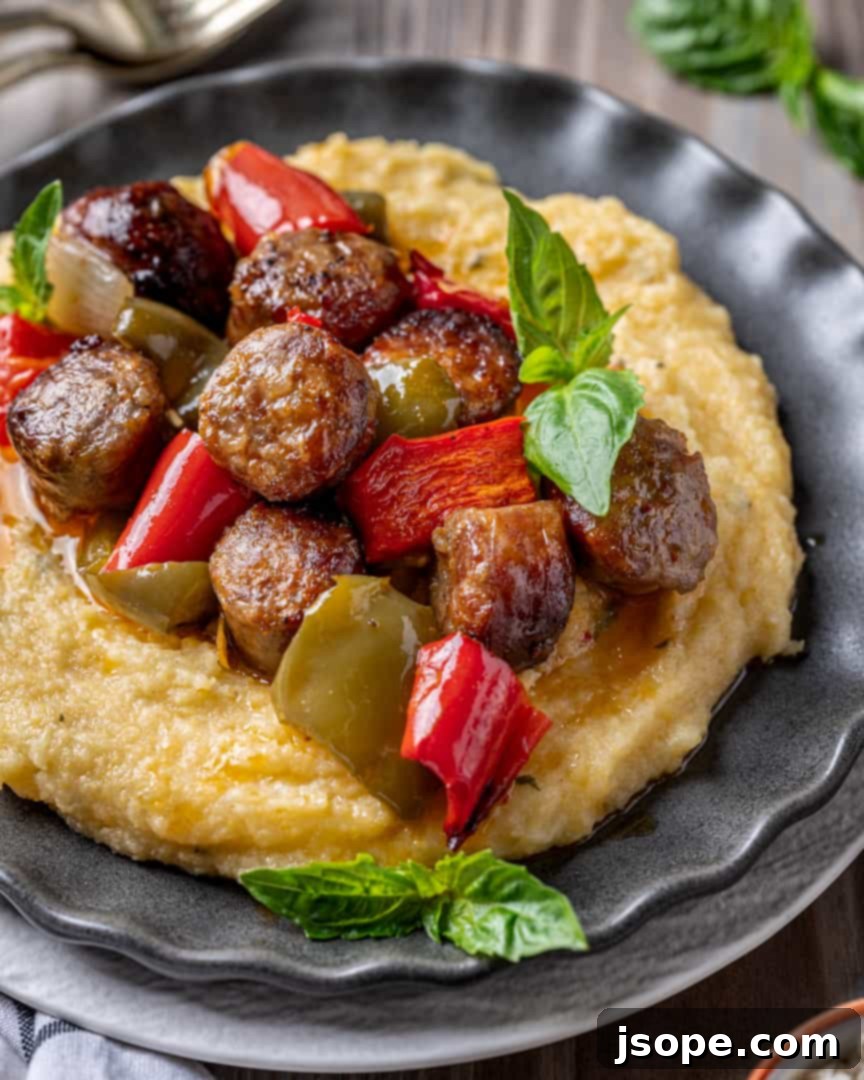
Wine Pairings to Complement Your Polenta
Pairing wine with polenta is an exciting endeavor, much like pairing with rice or pasta, as the primary consideration shifts to the accompanying dish rather than the grain itself. Polenta acts as a beautiful, neutral canvas that absorbs the flavors of whatever it’s served with. Therefore, tailoring your wine choice to the main components of your meal is key.
For robust red meats like beef ragù or braised short ribs, opt for bold red wines. A Cabernet Sauvignon, known for its structure and dark fruit notes, or a rich Merlot will stand up beautifully to the intense flavors. If your polenta is paired with poultry, lighter meats, or fish, a crisp, dry white wine is an excellent choice. Pinot Grigio offers refreshing acidity and subtle fruit, while a Sauvignon Blanc brings vibrant citrus and herbal notes.
However, if you’re enjoying the Brown Butter and Sage Polenta on its own, or if you wish to pair a wine specifically with the polenta’s unique flavors, a bold Chardonnay can be a fantastic match. Its creamy texture and notes of butter and oak (if oaked) echo the brown butter beautifully. Other wonderful choices that complement the earthy and savory profile of this specific polenta include a medium-bodied Pinot Noir, which offers delicate red fruit and earthy undertones, or a dry Italian Rosé, which provides a refreshing balance without overpowering the dish. Experimentation is encouraged to find your perfect pairing!
Delve Deeper: Explore More Italian Recipes
If this taste of Northern Italian comfort has ignited your passion for authentic Italian cuisine, there’s much more to discover. You can find a comprehensive collection of traditional and contemporary Italian dishes under our Classic Italian Recipes section, meticulously curated to bring the essence of Italy to your kitchen.
For those who wish to truly immerse themselves in Italian cooking, we are proud to offer our cookbook, Mangiamo. This essential guide features 60 incredibly delicious Italian and Italian-inspired recipes, perfect for expanding your culinary repertoire and impressing your guests with genuine Italian flavors.
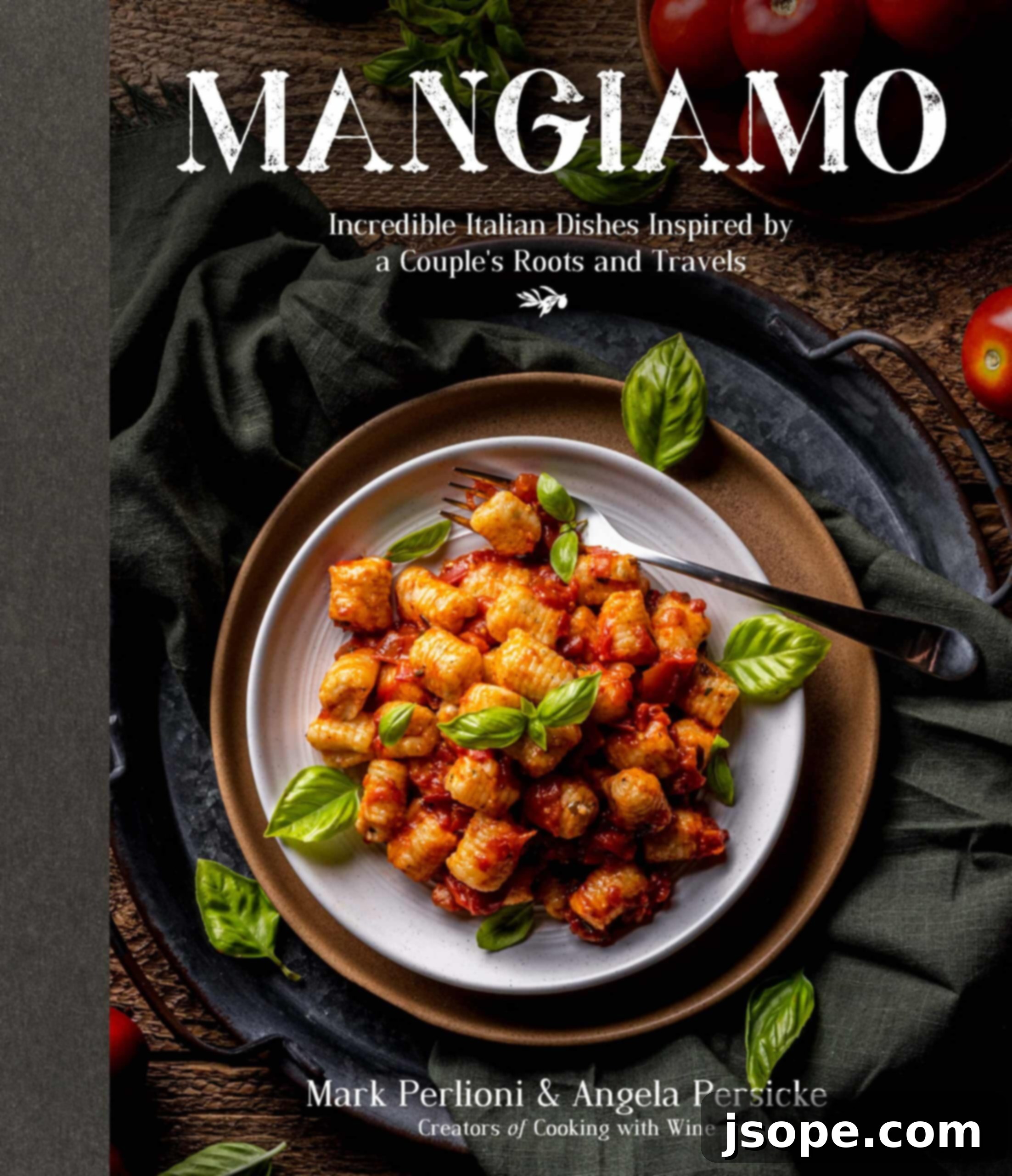
Frequently Asked Questions About Polenta
Here are answers to some common questions about polenta, providing further insight into this wonderful Italian staple:
Absolutely! Polenta is inherently gluten-free, as it is made entirely from corn. However, it is crucial to always read the product label carefully. Some manufacturers process their cornmeal on shared equipment that also handles wheat flour, which can lead to cross-contamination. Look for certifications or disclaimers indicating it’s processed in a dedicated gluten-free facility if you have severe gluten sensitivities.
This is a common point of confusion! Technically, “polenta” refers to the finished dish, not the raw ingredient. The main ingredient, however, is a specific type of coarse-ground cornmeal, traditionally derived from Italian flint corn. Generic “cornmeal” available in stores might not be made from flint corn and is often ground differently (e.g., finer or more irregularly). While you can certainly make a “porridge” similar to polenta using coarse-ground generic cornmeal (avoid fine-ground), it will likely have slight differences in taste and texture compared to true polenta made from flint corn.
Italians enjoy polenta in a multitude of delicious ways, many of which are highlighted in this article. The two most traditional and popular forms are creamy polenta, like this recipe, served warm and soft, and firm polenta, which is cooled, cut into shapes (discs, cubes, or even irregular pieces), and then fried, baked, or grilled until crispy. Creamy polenta often serves as a comforting base for rich meat sauces (ragù), stews, cheeses, or sautéed vegetables. Crispy polenta can be an appetizer, a side dish, or even a component of a main course, topped with anything from fresh tomatoes and basil to savory meats and seafood. It’s a incredibly versatile staple in Italian cuisine.
The choice of liquid for cooking polenta largely depends on preference and desired outcome, while also considering tradition. Traditionally, polenta is made with water. This method allows the pure, subtle flavor of the corn to truly shine through, appealing to purists. However, using a good quality vegetable (or other) stock, as we do in this recipe, will infuse the polenta with an additional layer of savory depth, enriching the overall flavor while still allowing the corn’s essence to be appreciated. We generally do not recommend using milk as the primary cooking liquid. While it is a liquid, milk tends to make the polenta very thick and can result in a somewhat pasty texture. If you desire extra richness or need to thin out polenta at the very end, a splash of milk or cream can be used sparingly, but for the initial cooking, stock or water is superior.
Related Recipes to Inspire Your Italian Cooking
If you’re looking for other delicious recipes that complement or share similar culinary traditions with this Brown Butter and Sage Polenta, explore these fantastic options:
- Homemade Butternut Squash Ravioli Recipe
- Italian Herb Sautéed Zucchini Squash Recipe
- Garlic Herb Sautéed Italian Eggplant Recipe
- Pan Fried Risotto Cakes – Easy Leftover Risotto Recipe
Pairing Suggestions for Brown Butter and Sage Polenta
Here are some of our absolute favorite main dishes that exquisitely complement the rich flavors of this Brown Butter and Sage Polenta, transforming any meal into a truly memorable experience:
- Marinated Lamb Chops with Mint and Cilantro Yogurt Sauce
- Dry-Rubbed Roasted Pork Tenderloin Recipe
- Grilled Marinated Tri Tip Steak – Ultimate Marinade Recipe
- Crispy Sous Vide Pork Belly Bites with Ginger Soy Glaze
📖 Recipe
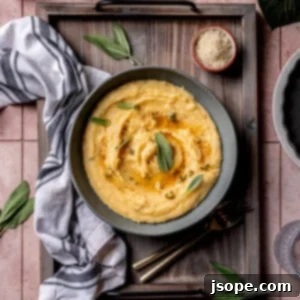
Brown Butter and Sage Polenta
Pin Recipe
Ingredients
- 6 large fresh sage leaves
- 8 Tablespoons unsalted butter divided
- 4 ½ cups vegetable stock – unsalted and high quality
- 9 oz Polenta-style instant cornmeal
- ¾ cup grated Parmesan cheese
- 2 teaspoon kosher salt
- ½ teaspoon black pepper
- Extra sage leaves to garnish optional
Instructions
- Chop the sage first, as you’ll need it as soon as the brown butter has been made. They don’t need to be finely chopped.
- Next make the brown butter. Place 6 tablespoons of butter in a small saucepan over medium heat. Cook until the milk solids in the butter brown and the aroma is nutty. Remove from the heat, place in a small bowl and add the sage to the brown butter. Set aside.
- Bring the stock to a boil. Once boiling, remove from the heat and, stirring constantly, slowly add the polenta. Do not add the polenta too quickly or it will become lumpy. Stir for 3 minutes, the polenta should be creamy. If it is very thick, thin it out with a little water or stock.
- Incorporate the brown butter and sage into the polenta by stirring. Be patient, it takes a minute or so. Stir in the cheese, salt, pepper, and remaining 2 tablespoons of butter until fully incorporated. Taste for additional seasoning. Serve!
Notes
Nutrition
Food Safety Guidelines
Prioritizing food safety is essential in any kitchen to prevent foodborne illnesses and ensure a healthy cooking environment. Please observe the following guidelines:
- Never leave cooking food unattended on the stovetop or in the oven. Always be present to monitor temperatures and prevent burning or other mishaps.
- Ensure good ventilation when using a gas stove. Proper airflow helps to dissipate cooking fumes and maintains air quality in your kitchen. Consider turning on your range hood or opening a window.
For more comprehensive information on safe food handling and preparation practices, please refer to the resources available at USDA.gov.
